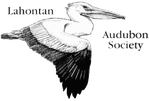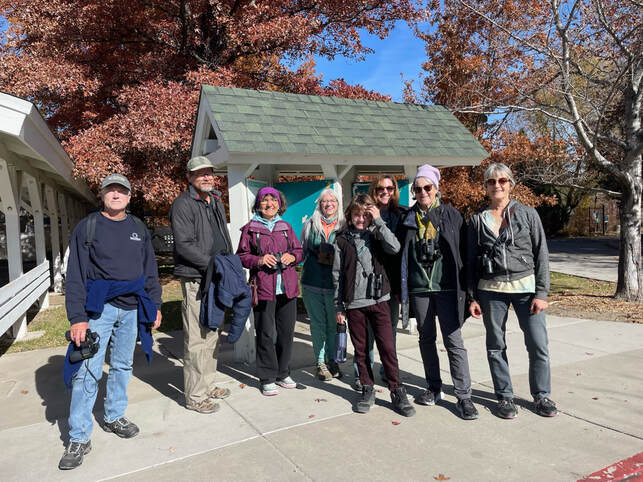|
By Steven Cavros With endless desert to the North, South and East, and several sprawling national forests to the West, Reno and the Lahontan Valley are like nowhere else in the world. The unique blend of the montane forest and the desert scrub is one of the most amazing things about Northern Nevada. Oases in the empty, barren deserts throughout the state attract a plethora of Eastern U.S. migrants every year, and the big water bodies like Pyramid and Washoe Lake can draw in any of a wide variety of primarily coastal ducks and shorebirds. Throughout this year, the lakes and marsh complexes in the Northwest of the state have drawn birds such as Hudsonian Godwits, Royal Terns and Parasitic Jaegers, but a quick drive through this warm desert state might not reveal everything it has to offer. And a quick look at the Casinos and other venues of urban Reno certainly don’t capture the state’s majesty. Upon my arrival in Reno, coming from Florida, I was shocked by my early outings, when I discovered only Canada Geese and pigeons at many of the local parks. But, popular as these spots might be, they’re not always the answer for a great birding experience. Whether it’s a day of gulling in the wind and cold at Sparks Marina in January or a trip out to Carson Lake in the Fall, the best places to find birds can be both close and far-but aren’t always where you’d expect. Some of the state’s best desert oases, for example, such as the town of Tonopah and the town of Gerlach, aren’t much to see- a few washed-out sheds and a couple of scraggly trees; but, in remote areas, just a few trees and an irrigated lawn is all it takes to draw in large numbers of rarities. In September of this year, I signed myself up for the American Birding Association young birder mentoring program. This required the participants to participate in some form of community education and activism. I wanted to lead a few bird walks, but wasn’t quite sure what I could do to improve my project; I needed to make it more specific, not just a string of semi-random bird walks throughout the Reno area. However, when I considered my experience as a new Reno resident, I was able to come to a conclusion for my project; leading bird walks at urban, accessible locations, to show new birders and Reno residents how to find more than Mallards and House Sparrows in their local parks and communities. Once people understand the abundant and beautiful nature all around them, they can come together to protect it-but, from the outside, Reno and Nevada as a whole can look pretty nondescript. Reno is certainly unique-but not bland. Throughout the changing seasons, consistent birding around Reno often pays off with excellent rarities and rewarding experiences. But like everywhere else, birds and wildlife in Reno and all over the Silver State are forced to adapt to more urban environments. “Of the ~250 bird species known or suspected to be breeders [in Nevada] during the period of [Breeding Birds of Nevada] Atlas fieldwork,” says author and birder Ted Floyd, “fully 100 had increasing population trends, and another 100 had decreasing populations trends.” This means that as recently as the early 2000s, about 80% of Nevada breeding bird populations were rising or shrinking, and even in the last 20 years, development and population growth has altered Nevada’s landscape even more. “Everything's changing!,” concluded Floyd. And this is very true-humans have changed Nevada forever, like they have changed the rest of the country and much of the world. Despite the fact that human presence is rarely a good thing for native habitat and wildlife, urban oases preserved around Reno and other cities across the country provide key habitat for species trying to hang on. In early November 2023, I was able to co-lead my first bird walk with Lahontan Audubon Society, at a familiar urban park, Rancho San Rafael. Many Reno residents will know the park for its size and recreational opportunities; it is a real urban gem with tons of space. Its size allows it to facilitate many bird species throughout the many trees, creeks and four small ponds within the area. The outcome for this first walk was good for early November and I was happy to see so many new and familiar faces; perhaps most importantly, however, I saw that people cared. Throughout the rest of my walks, the attendances weren’t always huge. My smallest attendance was a rather unimpressive four people, but my highest was at least a dozen, and perhaps the attendance on a single, or a few bird walks doesn’t really matter. Every day varies in weather, birdiness and visibility. But the thing that really mattered to me was that there were people- people who cared enough to come out at around eight in the morning and watch the urban birds for hours in a variety of temperatures and weather conditions. Some people who came on the bird walks knew a lot, but many did not. Many people who, if reached in the right way, could have their enjoyment for birds turned into a drive for the conservation and protection of birds. When something is gone, it is gone forever, and that is true for every individual bird. And, while some news headlines and the world at large might make the conservation struggle seem hopeless, it isn’t. People care. This was the most important thing that I learned, trekking through urban oases such as Swan Lake Nature Study Area, Sparks Marina Park and Virginia Lake. On every walk we found something different, and on every walk I met someone different, someone else who cared, but perhaps someone who didn’t quite know why or how to help the birds around them. I try to communicate what I can during three hour bird walks but this obviously isn’t enough; what is needed is a group effort to educate, to teach people about how to protect the birds that they already care a lot about. This is an effort that everyone can take part in, and a global effort that is already heavily underway. But even here, in our corner of Northern Nevada, nestled between the mountains and the sage, is a community of people who really care about the wildlife around them, and who are ready and willing to learn and work hard to create a better tomorrow for birds and people. |
topics
All
Archives
July 2024
|



 RSS Feed
RSS Feed